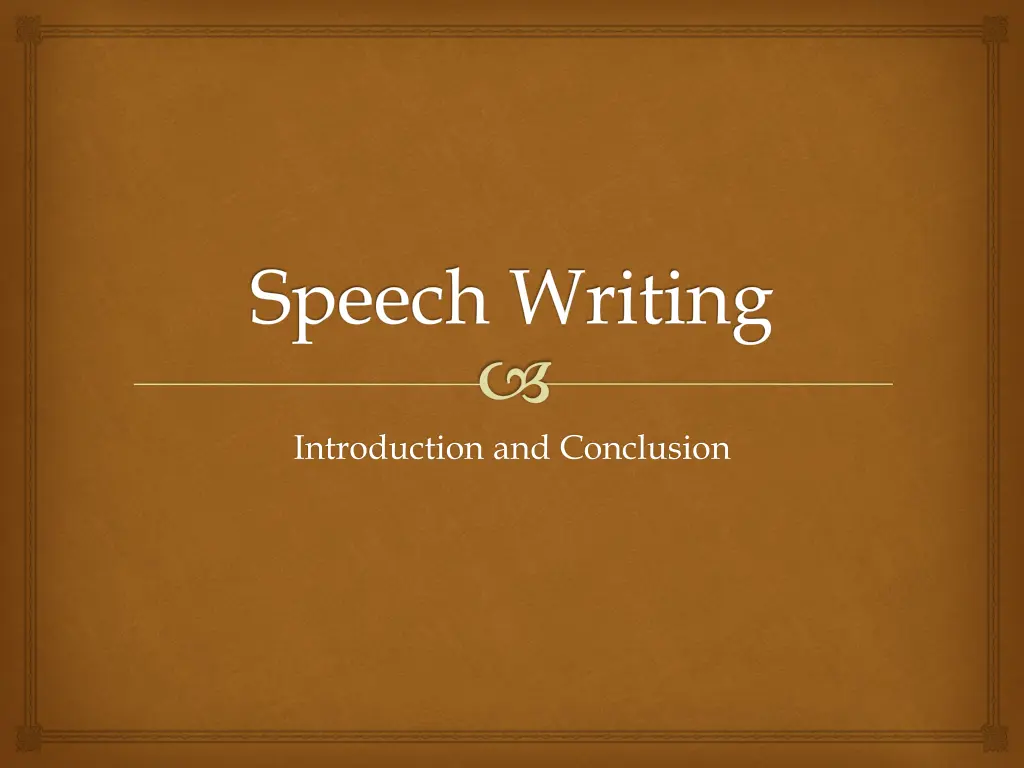
Crafting a Powerful Speech: Introduction and Conclusion
Learn how to develop a specific purpose for your speech, write an informative purpose statement, and structure your speech with a compelling introduction and conclusion. Discover the key elements that will help you effectively engage your audience and deliver your message with impact.
Download Presentation

Please find below an Image/Link to download the presentation.
The content on the website is provided AS IS for your information and personal use only. It may not be sold, licensed, or shared on other websites without obtaining consent from the author. If you encounter any issues during the download, it is possible that the publisher has removed the file from their server.
You are allowed to download the files provided on this website for personal or commercial use, subject to the condition that they are used lawfully. All files are the property of their respective owners.
The content on the website is provided AS IS for your information and personal use only. It may not be sold, licensed, or shared on other websites without obtaining consent from the author.
E N D
Presentation Transcript
Speech Writing Introduction and Conclusion
Develop your Purpose Determine your REASON for speaking: General purposes: inform, persuade, entertain Specific purpose: Complete sentence that begins with After listening to my speech, my audience will . If you don t know your purpose, DON T start writing your speech yet!
Writing a Specific Purpose Statement To Inform When writing your specific purpose statement for an Informative Speech, use descriptive verbs. For example, After listening to my speech, my audience will Know more about.. Understand the differences Recognize the benefits NOTE: Your purpose in this speech is to INFORM your classmates about the issue you researched this second semester.
Writing the Speech: Three basic elements Introduction Body Conclusion
Introduction Refer to the audience, occasion , something familiar Cite a startling fact or opinion Ask a yes/no, raise-your- hand, or rhetorical question Tell a brief story Use a quote Tell a relevant joke Four basic functions: Get audience attention
Introduction Your thesis is one sentence that tells your audience what the entire speech is about. It is NOT an English paper thesis. Be direct. A proposition is used in a persuasive speech. It states your POSITION on the topic, as well as what you hope to accomplish with the speech. Four basic functions: Get audience attention State your thesis or proposition
Introduction Four basic functions: Get audience attention State your thesis or proposition Establish your credibility Why are you an authority on the topic? Why did you choose this topic? State if you have experience with the topic or if you have done research.
Introduction Four basic functions: Get audience attention State your thesis or proposition Establish your credibility Preview your main points Directly state or list the 3-5 main points BRIEFLY that you plan to make. This should be a clear list. It should correspond exactly with your main points.
Example: General Purpose: To Inform Specific Purpose: By the end of my speech, my audience will know how to manage their school, work , and personal time effectively. (NOTE: I wouldn t SAY either the general or specific purpose, I would just start my speech at my attention getter.) Attention getter: How many people in here have a hard time balancing school work, working, family, and personal time? Thesis: For many of you in here, time management can be a major struggle, but it doesn t have to be. Credibility: I ve been effectively using time management strategies for years now, and it has made my life much easier to balance. Preview: First, I ll discuss how to manage your school time, then work time, and lastly family and personal time.
Remember! Practice your introduction many times! It should set the tone for your entire speech so it should be enthusiastic and fluent. Also, it should be NO LONGER than 30-45 seconds in your informative speech.
In General Conclusion Transition over completely to conclusion So as you can see or To conclude Then SUMMARIZE THE POINTS AGAIN. First I told you about (point 1), then I discussed (point 2) and lastly, I explained (point 3). End with a memorable thought
Tips for an Effective Conclusion Do not end abruptly Don t ramble Don t introduce new points Don t apologize DON T say That s it or I guess that s my speech or That s all I ve got thanks.
